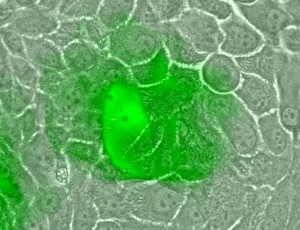Germain L, Zack DJ & al. Functional genomic screening identifies dual leucine zipper kinase as a key mediator of retinal ganglion cell death. Proceedings of the National Academy of Sciences of the United-States of America, 110(10):4045-4050, mars 2013.
Authors: Derek S. Welsbie, Zhiyong Yang, Yan Gea, Katherine L. Mitchell, Xinrong Zhoua, Scott E. Martin, Cynthia A. Berlinicke, Laszlo Hackler, Jr.a , John Fuller, Jie Fua, Li-hui Cao , Bing Han, Douglas Aulde , Tian Xue, Syu-ichi Hirai, Lucie Germain, Caroline Simard-Bisson, Richard Blouin, Judy V. Nguyen, Chung-ha O. Davis, Raymond A. Enke, Sanford L. Boye, Shannath L. Merbs, Nicholas Marsh-Armstrong, William W. Hauswirth, Aaron DiAntonio, Robert W. Nickells, James Inglese, Justin Hanes, King-Wai Yau, Harry A. Quigley, and Donald J. Zack
Scientific impact: Glaucoma is a neurodegenerative optic neuropathy in which the death of retinal ganglion cells (RGC) is responsible for the vision loss. In order to develop new treatments for glaucoma, a high-throughput RNA interference experiments were performed and Dual Leucine zipper Kinase (DLK) was therefore identified as a required signaling protein in RGC death. The importance of DLK in this process was confirmed by in vitro and in vivo studies in which RGC survival following axonal injury was increased in RGC with reduced DLK expression or those treated with tozasertib (a DLK inhibitor). In accordance with these results, an increase DLK expression was also observed in rat retinal sections following optic nerve transection. This work allowed the identification of DLK as a therapeutic target and tozasertib as a therapeutic agent to be considered for the treatment of glaucoma and perhaps of other neurodegenerative diseases.
Network contribution: The Vision Health Research Network has contributed to this work through the development of a structure promoting the health vision research that support the execution of work as evidenced by this high level publication.
* * *
Original Abstract
Glaucoma, a major cause of blindness worldwide, is a neurodegenerative optic neuropathy in which vision loss is caused by loss of retinal ganglion cells (RGCs). To better define the pathways mediating RGC death and identify targets for the development of neuroprotective drugs, we developed a high-throughput RNA interference screen with primary RGCs and used it to screen the full mouse kinome. The screen identified dual leucine zipper kinase (DLK) as a key neuroprotective target in RGCs. In cultured RGCs, DLK signaling is both necessary and sufficient for cell death. DLK undergoes robust posttranscriptional up-regulation in response to axonal injury in vitro and in vivo. Using a conditional knockout approach, we confirmed that DLK is required for RGC JNK activation and cell death in a rodent model of optic neuropathy. In addition, tozasertib, a small molecule protein kinase inhibitor with activity against DLK, protects RGCs from cell death in rodent glaucoma and traumatic optic neuropathy models. Together, our results establish a previously undescribed drug/drug target combination in glaucoma, identify an early marker of RGC injury, and provide a starting point for the development of more specific neuroprotective DLK inhibitors for the treatment of glaucoma, nonglaucomatous forms of optic neuropathy, and perhaps other CNS neurodegenerations.
The overexpression of DLK, following a transuction by adenoviral vectors in epithelial skin cells in culture (in green), induces differentiation and cell death processes. The PNAS article shows that DLK is implicated in the death of retina cells.



